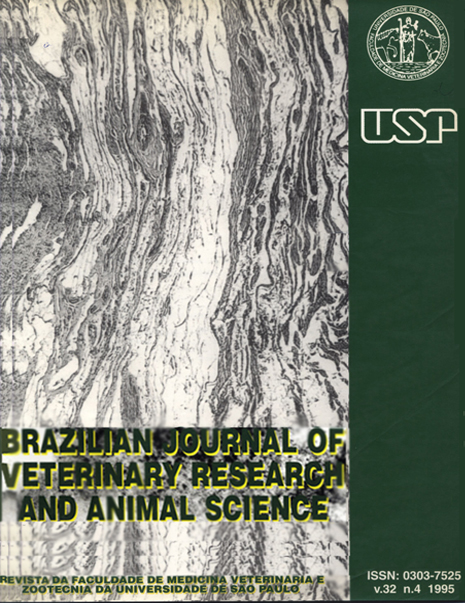Changes in the peritoneal fluid of horses with abdominal discomfort and its relations to the kind and evolution of the lesion after medical or surgical treatment: study of 74 cases
DOI:
https://doi.org/10.11606/issn.1678-4456.bjvras.1994.52120Keywords:
Equidae, Colic, Abdome, Ascitie fluidAbstract
The purpose of this paper is to view the interrelation between the peritoneal fluid analysis from horses with abdominal discomfort, regarding the pathology site, the occurrence or not of strangulating obstruction, the treatment performed and the presence of peritoneal fluid, classified either as modified transudate or exsudate. In order to achieve that, 373 clinical records of colicky horses referred to the Veterinary Hospital between 1985 and 1991 were studied, and 98 of these, were selected, in which peritoneal fluid sampling and analysis had been carried out in a routine manner. Greater amount of exsudate than that of modified transudate was observed. Horses with wide spread intestinal disease showed the best recovery rates. Regardless of the site of the lesion, those exhibiting strangulating obstruction had the lowest rates of survival, and this kind of obstruction was more frequently observed in the small intestine. Among the parameters considered in the peritoneal fluid analysis, fluid color was the most reliable indicator od strangulating obstruction and/or intestinal ischemia. Finally, peritoneal fluid analysis and citology alone were not sufficient to diagnose the cause of the colic, due to the great variation observed in each pathology group: associated to the clinical evaluation of the patient, however, they can bring up the need for surgical intervention.Downloads
Download data is not yet available.
Downloads
Published
1995-12-04
Issue
Section
ANIMAL PATHOLOGY
License
The journal content is authorized under the Creative Commons BY-NC-SA license (summary of the license: https://
How to Cite
1.
Baccarin RYA, Thomassian A, Nicoletti JLM, Gandolfi W, Hussni CA, Lopes RS. Changes in the peritoneal fluid of horses with abdominal discomfort and its relations to the kind and evolution of the lesion after medical or surgical treatment: study of 74 cases. Braz. J. Vet. Res. Anim. Sci. [Internet]. 1995 Dec. 4 [cited 2024 Apr. 20];32(4):256-65. Available from: https://www.revistas.usp.br/bjvras/article/view/52120





